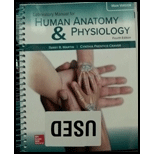
Laboratory Manual For Human Anatomy & Physiology
4th Edition
ISBN: 9781260159080
Author: Martin, Terry R., Prentice-craver, Cynthia
Publisher: Mcgraw-hill Education,
expand_more
expand_more
format_list_bulleted
Concept explainers
Textbook Question
Chapter 23, Problem 5PL
The belly of the muscle is usually ________ the region pulled.
a. located on
b. opposite
c. distal to
d. proximal to
Expert Solution & Answer
Want to see the full answer?
Check out a sample textbook solution
Students have asked these similar questions
When this large muscle contracts, the vertical dimensions of the thoracic cavity increase. a. external intercostal b. internal intercostal c. diaphragm d. transversus thoracis
Answer as soon as possible
Blood is forced out of the penile lacunae bycontraction of the ______a. bulbospongiosus muscle.b. ischiocavernosus muscle.c. cremaster.d. trabecular muscles.e. dartos fascia.
Chapter 23 Solutions
Laboratory Manual For Human Anatomy & Physiology
Ch. 23 - Chest and shoulder muscles that move the arm at...Ch. 23 - Muscles located in the arm that move the forearm...Ch. 23 - Rotator cuff muscles all have origins on the a....Ch. 23 - Which of the following is not a rotator cuff...Ch. 23 - The belly of the muscle is usually ________ the...Ch. 23 - The belly of the flexor digitorumprofundus muscle...Ch. 23 - There are more muscles that move the forearm than...Ch. 23 - The action of the brachialis muscle is flexion of...Ch. 23 - FIGURE 23.7 Label the deep anterior muscles of the...Ch. 23 - Label the muscle of respiration of the posterior...
Ch. 23 - FIGURE 23.9 Identify the posterior muscles of the...Ch. 23 - FIGURE 23.10 Label the anterior muscles of the...Ch. 23 - FIGURE 23.11 Identify the anterior muscles of the...Ch. 23 - Match the muscles in column A with the actions in...Ch. 23 - Name the muscle indicated by the following...Ch. 23 - Name the muscle indicated by the following...Ch. 23 - Name the muscle indicated by the following...Ch. 23 - Name the muscle indicated by the following...Ch. 23 - Name the muscle indicated by the following...Ch. 23 - Name the muscle indicated by the following...Ch. 23 - Name the muscle indicated by the following...Ch. 23 - Name the muscle indicated by the following...Ch. 23 - Identify the muscles indicated in figure 23.12....Ch. 23 - Tendons of the rotator cuff muscles hold the head...
Knowledge Booster
Learn more about
Need a deep-dive on the concept behind this application? Look no further. Learn more about this topic, biology and related others by exploring similar questions and additional content below.Similar questions
- The muscle with a long and narrow tendon that travels inferiorly and medially between gastrocnemius and soleus. O a. Inserts into the posterior surface of the calcaneus O b. Is innervated by the common fibular nerve O Forms the inferomedial border of the popliteal fossa C. O d. Assists with dorsiflexion of the foot at the ankle jointarrow_forwardthe outermost layer, encircling the entire muscle is called.. O A. Epimysium O B. Perimysium OC. Endomysium O D. all answers are correctarrow_forwardExtension of hip joint will be affected if this muscle group is paralyzed. A. Obturator B. Abductor C. Adductor D. Glutealarrow_forward
- The rhomboid major and minor muscles are deep to the________.a. rectus abdominisb. scalene musclesc. trapeziusd. ligamentum nuchaearrow_forwardMatch the number on the diagram to the correct muscle. 21 A. sartorius 1 B. quadriceps femoris 2 C. tibialis anterior v3 D.biceps femoris 4 E. gastrocnemiusarrow_forwardWhat type of muscles are these Type 1, Type 2a or 2b? A. orbicularis oculi, Buccinator and platysma musclearrow_forward
- This muscle is a pyramid shaped muscle of facial expression. This muscle lies beneath the frontalis and orbicularis oculi. a. Procerus b. Corrugator c. Risorius d. Digastricarrow_forwardBoth the gastrocnemius and _____ muscles insert on the heel by way of the calcaneal tendon:- a. semimembranosus b. tibialis posterior c. tibialis anterior d. soleus e. plantarisarrow_forwardWhich of these is not a suprahyoid muscle? a. genioglossus b. geniohyoid c. stylohyoid d. mylohyoid e. digastricarrow_forward
- Which of the following muscles is an extrinsic (Axio-appendicular) muscle of the back? A. Levator Scapulae B. Deltiod C. Erector Spinae D. Splenius Capitisarrow_forwardMuscles with a triangular shape, such as the pectoralis major muscle in the chest, typically have a: a. convergent fascicle arrangement. b. spiral fascicle arrangement. c. parallel fascicle arrangement. d. unipennate fascicle arrangementarrow_forwardThe patella is embedded in the tendon of the _____ musclearrow_forward
arrow_back_ios
SEE MORE QUESTIONS
arrow_forward_ios
Recommended textbooks for you
 Fundamentals of Sectional Anatomy: An Imaging App...BiologyISBN:9781133960867Author:Denise L. LazoPublisher:Cengage Learning
Fundamentals of Sectional Anatomy: An Imaging App...BiologyISBN:9781133960867Author:Denise L. LazoPublisher:Cengage Learning Medical Terminology for Health Professions, Spira...Health & NutritionISBN:9781305634350Author:Ann Ehrlich, Carol L. Schroeder, Laura Ehrlich, Katrina A. SchroederPublisher:Cengage Learning
Medical Terminology for Health Professions, Spira...Health & NutritionISBN:9781305634350Author:Ann Ehrlich, Carol L. Schroeder, Laura Ehrlich, Katrina A. SchroederPublisher:Cengage Learning

Fundamentals of Sectional Anatomy: An Imaging App...
Biology
ISBN:9781133960867
Author:Denise L. Lazo
Publisher:Cengage Learning

Medical Terminology for Health Professions, Spira...
Health & Nutrition
ISBN:9781305634350
Author:Ann Ehrlich, Carol L. Schroeder, Laura Ehrlich, Katrina A. Schroeder
Publisher:Cengage Learning


Types of Human Body Tissue; Author: MooMooMath and Science;https://www.youtube.com/watch?v=O0ZvbPak4ck;License: Standard YouTube License, CC-BY